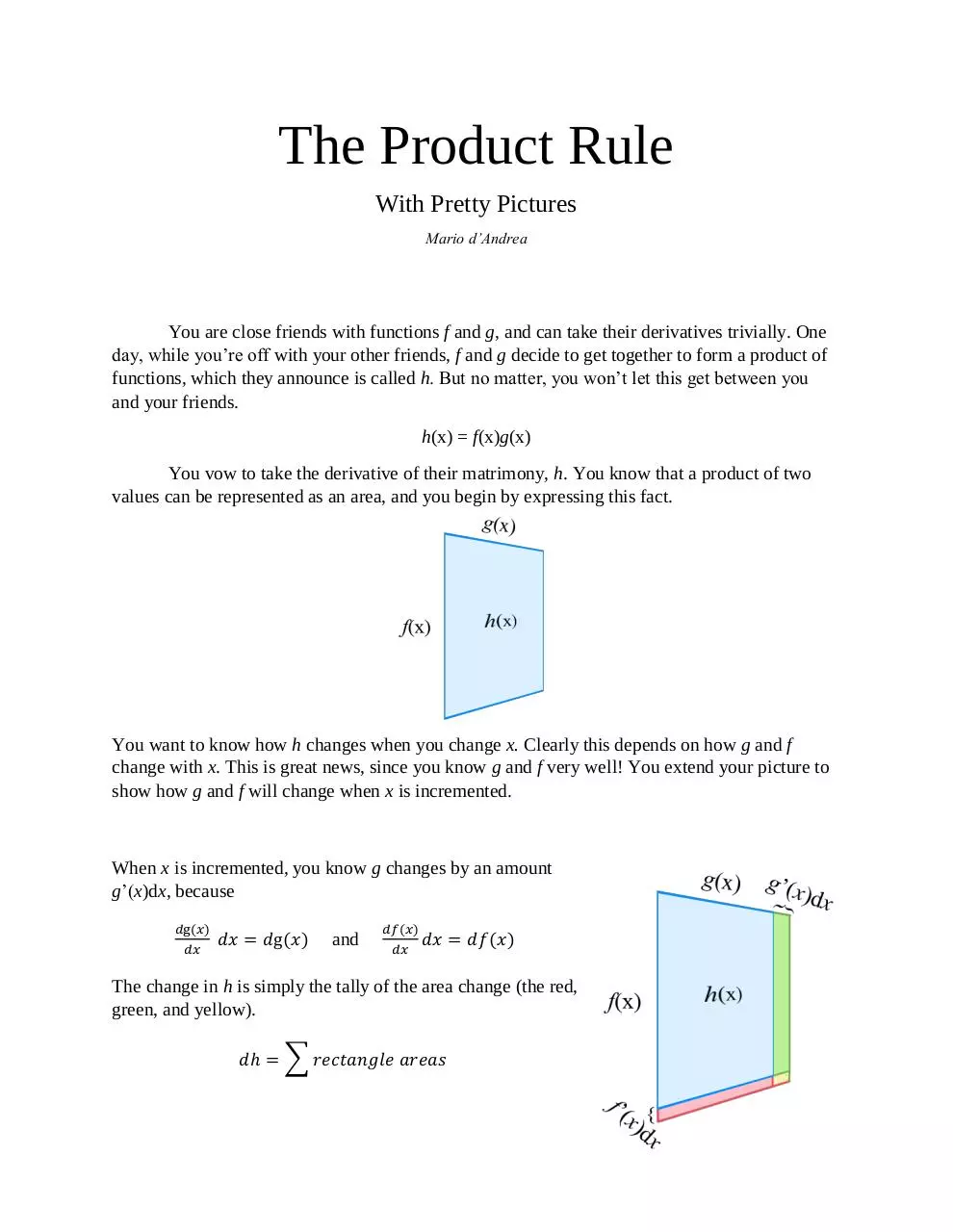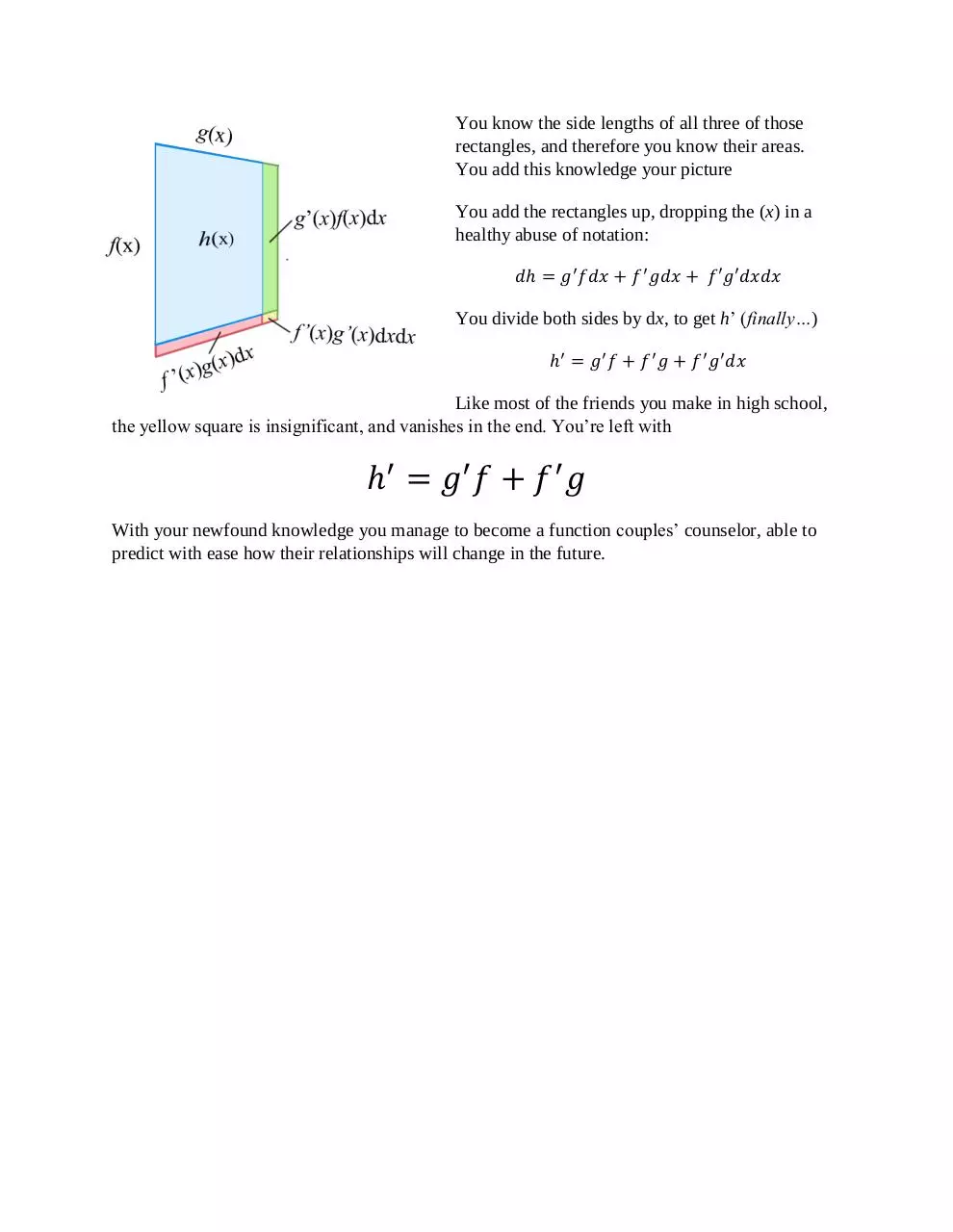The Product Rule (2) (PDF)
File information
Author: Mario d'Andrea
This PDF 1.5 document has been generated by Microsoft® Word 2016, and has been sent on pdf-archive.com on 02/09/2016 at 23:30, from IP address 108.245.x.x.
The current document download page has been viewed 640 times.
File size: 633.32 KB (6 pages).
Privacy: public file





File preview
The Product Rule
With Pretty Pictures
Mario d’Andrea
You are close friends with functions f and g, and can take their derivatives trivially. One
day, while you’re off with your other friends, f and g decide to get together to form a product of
functions, which they announce is called h. But no matter, you won’t let this get between you
and your friends.
h(x) = f(x)g(x)
You vow to take the derivative of their matrimony, h. You know that a product of two
values can be represented as an area, and you begin by expressing this fact.
You want to know how h changes when you change x. Clearly this depends on how g and f
change with x. This is great news, since you know g and f very well! You extend your picture to
show how g and f will change when x is incremented.
When x is incremented, you know g changes by an amount
g’(x)dx, because
𝑑g(𝑥)
𝑑𝑥
𝑑𝑥 = 𝑑g(𝑥)
and
𝑑𝑓(𝑥)
𝑑𝑥
𝑑𝑥 = 𝑑𝑓(𝑥)
The change in h is simply the tally of the area change (the red,
green, and yellow).
𝑑ℎ = ∑ 𝑟𝑒𝑐𝑡𝑎𝑛𝑔𝑙𝑒 𝑎𝑟𝑒𝑎𝑠
You know the side lengths of all three of those
rectangles, and therefore you know their areas.
You add this knowledge your picture
You add the rectangles up, dropping the (x) in a
healthy abuse of notation:
𝑑ℎ = 𝑔′𝑓𝑑𝑥 + 𝑓 ′ 𝑔𝑑𝑥 + 𝑓′𝑔′𝑑𝑥𝑑𝑥
You divide both sides by dx, to get h’ (finally…)
ℎ′ = 𝑔′ 𝑓 + 𝑓 ′𝑔 + 𝑓 ′ 𝑔′𝑑𝑥
Like most of the friends you make in high school,
the yellow square is insignificant, and vanishes in the end. You’re left with
ℎ′ = 𝑔′ 𝑓 + 𝑓 ′ 𝑔
With your newfound knowledge you manage to become a function couples’ counselor, able to
predict with ease how their relationships will change in the future.
The Power Rule Wants in on the Fun
A.k.a, when something works, reuse it
You’re happily counseling (differentiating) all manner of couples (product functions),
when you notice that the power rule as it applies to y = x2 can just be seen as a special case of the
product rule, where the two function are f = x and g = x , so that
𝑦 ′ = 𝑓 ′𝑔 + 𝑔′𝑓 = (1)𝑥 + 𝑥 (1) = 2𝑥
You’re very pleased by this, and you decide to draw a
picture to express this joy.
A small change in x causes the area to change by
𝑑𝑦 = 𝑥𝑑𝑥 + 𝑥𝑑𝑥 + 𝑑𝑥𝑑𝑥
𝑦 ′ = 2𝑥 + 𝑑𝑥
𝑦 ′ = 2𝑥
Power Increasing
You wonder how this could apply to polynomials of higher order. The next obvious case
is y = x . For this, you know that a triple product can be viewed as a volume.
3
If you’re paying attention, you’ll have noticed that I didn’t fill in the edges and corner of the
cube. This was only because it would be annoying to draw. Below is a visual tally of the parts:
In total, this gives the change in the function y = f(x) = x3 as x changes.
𝑑𝑦 = 3𝑥 2 𝑑𝑥 + 3𝑥𝑑𝑥𝑑𝑥 + 𝑑𝑥𝑑𝑥𝑑𝑥
𝑑𝑦
𝑑𝑥
= 3𝑥 2 + 3𝑥𝑑𝑥 + 𝑑𝑥𝑑𝑥
(dx vanishes in the limit)
𝑦 ′ = 3𝑥 2
This is such a lovely pattern; it would be fun if we could keep going. Unfortunately, your
feeble human mind can only imagine shapes up to three dimensions, so we’ll have to rely on
induction to fill in the gaps in our intuiti – just kidding!
Hold on to Your Axioms, We’re Going In
That’s right, right here in this very write-up you’ll be journeying into the great beyond in
full technicolor. But first, a quick note about spatial dimensions (so you don’t get too excited).
The Fourth Dimension Isn’t Time, You Disgusting Heathen
This isn’t physics, you aren’t Einstein, and until otherwise stated, additional dimensions
are not time. Sure, when given a function with parameters, you can imagine that one of them is
time. Of course you can label the x-axis as t. This doesn’t change that when talking about ℝ4
(how cool people say four dimensions), we mean four orthogonal and completely
interchangeable directions: none of them are special. There are the x, y, z, and w directions, each
as boring as the last. Got it? Good.
Square is to Cube as Cube is to ???
Consider the projection of a cube onto a 2D surface, with perspective:
When squashed into 2D from this angle, this strange 3D-square must lose some orthogonality.
To view the cube from another angle by rotating it, the small, “back” face will warp and enlarge
until it seems to disappear, becoming the “front” face.
Notice how when naively counting the number of “cells” in the 3-square, a 2D being would be
tempted to count only five, when we know the front face brings the count to six sides.
Constructing the Tesseract:
You can imagine constructing our favorite hypercube in the following way:
1-dimensional: Two points A and B can be connected to a line, giving a new line
segment AB.
2-dimensional: Two parallel line segments AB and CD can be connected to become a
square, with the corners marked as ABCD.
3-dimensional: Two parallel squares ABCD and EFGH can be connected to become a
cube, with the corners marked as ABCDEFGH.
4-dimensional: Two parallel cubes ABCDEFGH and IJKLMNOP can be connected to
become a hypercube, with the corners marked as ABCDEFGHIJKLMNOP
Behold! This is a 2D rendition of a 3D projection of a 4D
tesseract, so don’t take it too literally – it’s all bent out of
shape. If you want to learn more about this, read
something about higher dimensional shapes, not a piece
about the power rule.
It’s Time to Change x
The moment we’ve all been waiting for: prepare to regret choosing to continue this visual
journey, and behold this horrible creation:
Drawing this diagram is left as an exercise for the reader.
Download The Product Rule (2)
The Product Rule (2).pdf (PDF, 633.32 KB)
Download PDF
Share this file on social networks
Link to this page
Permanent link
Use the permanent link to the download page to share your document on Facebook, Twitter, LinkedIn, or directly with a contact by e-Mail, Messenger, Whatsapp, Line..
Short link
Use the short link to share your document on Twitter or by text message (SMS)
HTML Code
Copy the following HTML code to share your document on a Website or Blog
QR Code to this page

This file has been shared publicly by a user of PDF Archive.
Document ID: 0000479743.